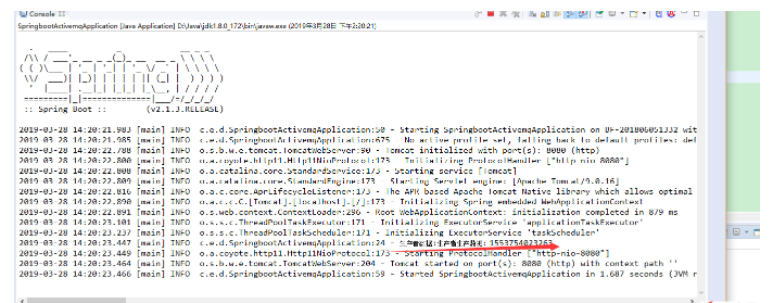
1. Simple routing
php editor Baicao will give you an in-depth analysis of the message routing strategy of Java ActiveMQ. Message routing is a crucial part of the message middleware system and directly affects the performance and reliability of the system. In ActiveMQ, how is the message routing strategy designed and implemented? What are the characteristics and applicable scenarios of different routing strategies? Through the analysis of this article, let us have an in-depth understanding of the mysteries of Java ActiveMQ message routing strategy.
<route> <from uri="queue:inbox"/> <to uri="queue:outbox"/> </route>
The above configuration will route all messages sent to the inbox queue to the outbox queue.
2. Destination routing
Destination routing policies allow messages to be routed to multiple destinations. The configuration of this policy is more complicated than a simple routing policy and requires specifying the names of multiple destinations.
<route> <from uri="queue:inbox"/> <to uri="queue:outbox1"/> <to uri="queue:outbox2"/> </route>
The above configuration will route all messages sent to the inbox queue to both the outbox1 and outbox2 queues.
3. Filter routing
Filter routing policy allows routing based on the attributes of the message. Configuration of this policy requires specifying a filter that is used to determine which messages should be routed to the target destination.
<route> <from uri="queue:inbox"/> <filter> <simple>header.priority == "high"</simple> </filter> <to uri="queue:outbox"/> </route>
The above configuration will route all messages with priority high to the outbox queue, while other messages will be discarded.
4. Load BalancingRouting
Load balancing routing policy allows messages to be routed evenly to multiple destinations. The configuration of this policy requires specifying the names of multiple destinations and the load balancing algorithm.
<route> <from uri="queue:inbox"/> <loadBalance> <roundRobin/> </loadBalance> <to uri="queue:outbox1"/> <to uri="queue:outbox2"/> </route>
The above configuration will route all messages sent to the inbox queue evenly to the outbox1 and outbox2 queues.
5. Summary
ActiveMQ Provides a variety of message routing strategies to meet the needs of different scenarios. This article analyzes the implementation principles of these routing strategies in detail, and shows how to use these routing strategies through demonstration code. I hope this article can help readers better understand and use ActiveMQ.
The above is the detailed content of Analyzing the message routing strategy of Java ActiveMQ. For more information, please follow other related articles on the PHP Chinese website!
 Java ActiveMQ 的 20 个最佳实践Feb 20, 2024 pm 09:48 PM
Java ActiveMQ 的 20 个最佳实践Feb 20, 2024 pm 09:48 PM1.选择合适的客户端传输协议ActiveMQ支持多种客户端传输协议,包括STOMP、AMQP和OpenWire。根据您的应用程序需求选择合适的协议,以优化性能和可靠性。2.配置消息持久性持久性消息即使在服务器重新启动后也能持久化,而非持久性消息则不会。对于关键消息,选择持久性以确保可靠传递。演示代码://设置消息持久性MessageProducerproducer=session.createProducer(destination);producer.setDeliveryMode(Deliv
 Java开发:如何使用Apache Camel进行消息路由和转换Sep 21, 2023 pm 04:24 PM
Java开发:如何使用Apache Camel进行消息路由和转换Sep 21, 2023 pm 04:24 PMJava开发:如何使用ApacheCamel进行消息路由和转换ApacheCamel是一个非常强大的开源集成框架,它能够帮助开发者轻松实现消息路由、转换、过滤等功能。本文将介绍如何使用ApacheCamel进行消息路由和转换,并提供具体的代码示例。引入ApacheCamel依赖在开始之前,我们需要在Java项目中引入ApacheCamel的依赖。在
 Java ActiveMQ 的 20 个高级技巧Feb 20, 2024 pm 09:51 PM
Java ActiveMQ 的 20 个高级技巧Feb 20, 2024 pm 09:51 PM1.消息路由使用JMSSelectors过滤消息:使用JMSSelectors根据消息属性对传入消息进行筛选,仅处理相关消息。创建自定义消息路由器:扩展ActiveMQ的路由功能,通过编写自定义路由器将消息发送到特定目的地。配置轮询负载均衡:将传入消息均匀分布到多个消息消费者,提高处理能力。2.持久性启用持久性会话:确保即使应用程序或服务器发生故障,消息也能持久存储,避免丢失。配置死信队列(DLQ):将处理失败的消息移至DLQ,以便重新处理或分析。使用Journal存储:提高持久性消息的性能,减
 Java ActiveMQ:轻松实现分布式系统的异步通信Feb 19, 2024 pm 10:18 PM
Java ActiveMQ:轻松实现分布式系统的异步通信Feb 19, 2024 pm 10:18 PMActiveMQ是Apache出品的一款开源消息中间件,它使用Java语言开发,具有可靠的消息传递、异步通信和集群支持等特点。ActiveMQ能够在不同的应用之间进行数据交换,并且支持多种消息协议,如JMS、AMQP和MQtT等。1.ActiveMQ的优势ActiveMQ是一款非常成熟的消息中间件,它具有以下优势:可靠的消息传递:ActiveMQ能够保证消息的可靠传递,即使在网络故障或服务器宕机的情况下,消息也不会丢失。异步通信:ActiveMQ支持异步通信,允许不同的应用之间进行非实时的通信。
 PHP和Apache Camel集成实现消息路由和交换Jun 25, 2023 am 09:37 AM
PHP和Apache Camel集成实现消息路由和交换Jun 25, 2023 am 09:37 AM随着企业规模的不断扩大和业务的不断增加,各种数据的传输和交换变得越来越复杂。如何高效地实现数据之间的交互以及数据的加工、处理和传输已成为企业架构设计中的重要考虑因素之一。而现代的企业架构设计通常采用轻量级框架和开源技术来解决这些问题,其中PHP和ApacheCamel是两个常见且被广泛使用的框架。PHP是一种流行的服务器端脚本语言,被广泛应用于
 怎么在SpringBoot中整合ActiveMQMay 11, 2023 pm 06:16 PM
怎么在SpringBoot中整合ActiveMQMay 11, 2023 pm 06:16 PM目录结构引入maven依赖org.springframework.bootspring-boot-starter-parent1.5.4.RELEASEUTF-8UTF-81.8org.springframework.bootspring-boot-starterorg.springframework.bootspring-boot-starter-weborg.springframework.bootspring-boot-starter-testtestorg.springframework
 Java JMS入门:轻松掌握消息传递技术的基础知识Feb 26, 2024 am 10:34 AM
Java JMS入门:轻松掌握消息传递技术的基础知识Feb 26, 2024 am 10:34 AM1.JavaJMS简介JavaJMS是一个用于建立、发送和接收消息的Javaapi。它提供了可靠的消息传递功能,非常适合分布式系统和企业级应用程序。消息传递系统可以将消息从一个应用程序发送到另一个应用程序,即使这两个应用程序位于不同的机器上。2.JMSAPIJMSAPI定义了一系列接口和类,用于发送和接收消息。这些接口和类包括:javax.jms.ConnectionFactory:用于创建连接到JMS服务器的连接。javax.jms.Connection:连接到JMS服务器的连接。javax.
 Springboot中如何整合ActivemqMay 21, 2023 pm 01:13 PM
Springboot中如何整合ActivemqMay 21, 2023 pm 01:13 PM1导入整合所需要的依赖:org.springframework.bootspring-boot-starter-activemq2创建application.properties文件spring.activemq.broker-url=tcp://127.0.0.1:61616spring.activemq.user=adminspring.activemq.password=adminserver.port=8080queue=myqueue3.自定义配置文件QueueConfig读取配置文件


Hot AI Tools

Undresser.AI Undress
AI-powered app for creating realistic nude photos

AI Clothes Remover
Online AI tool for removing clothes from photos.

Undress AI Tool
Undress images for free

Clothoff.io
AI clothes remover

AI Hentai Generator
Generate AI Hentai for free.

Hot Article

Hot Tools

SublimeText3 Chinese version
Chinese version, very easy to use

SublimeText3 Mac version
God-level code editing software (SublimeText3)

MantisBT
Mantis is an easy-to-deploy web-based defect tracking tool designed to aid in product defect tracking. It requires PHP, MySQL and a web server. Check out our demo and hosting services.

Dreamweaver CS6
Visual web development tools

DVWA
Damn Vulnerable Web App (DVWA) is a PHP/MySQL web application that is very vulnerable. Its main goals are to be an aid for security professionals to test their skills and tools in a legal environment, to help web developers better understand the process of securing web applications, and to help teachers/students teach/learn in a classroom environment Web application security. The goal of DVWA is to practice some of the most common web vulnerabilities through a simple and straightforward interface, with varying degrees of difficulty. Please note that this software







